DEM Generation Incorporating River Channels in Data-Scarce Contexts: The “Fluvial Domain Method”
Abstract
1. Introduction
2. Materials and Methods
2.1. Study Area Description
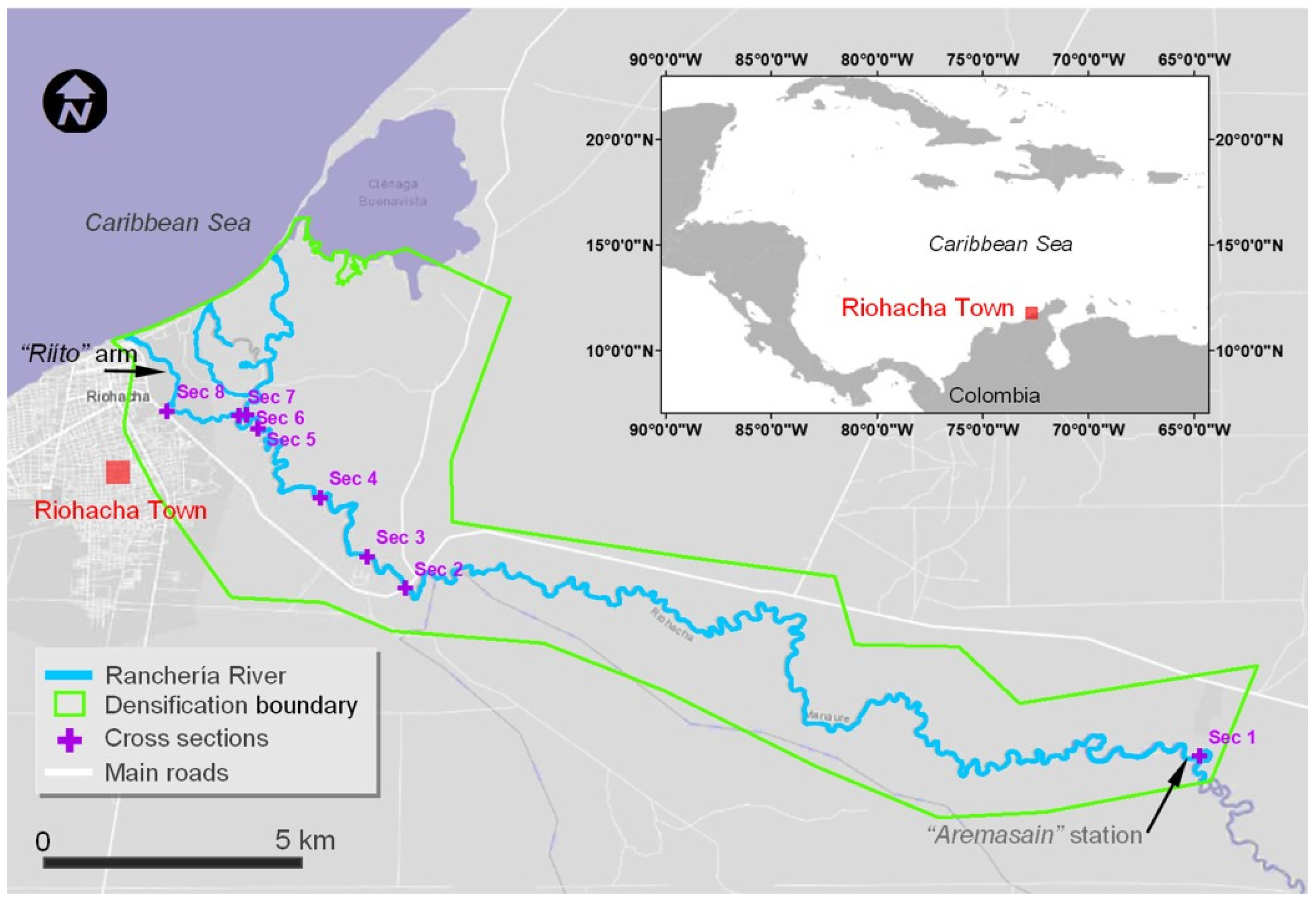

2.2. Datasets
2.2.1. Aerial Imagery for SfM-MVS Photogrammetric DEM Generation
2.2.2. Validation Topographic Field Data
2.2.3. Topographic Field Data for Final Altimetric Refinements
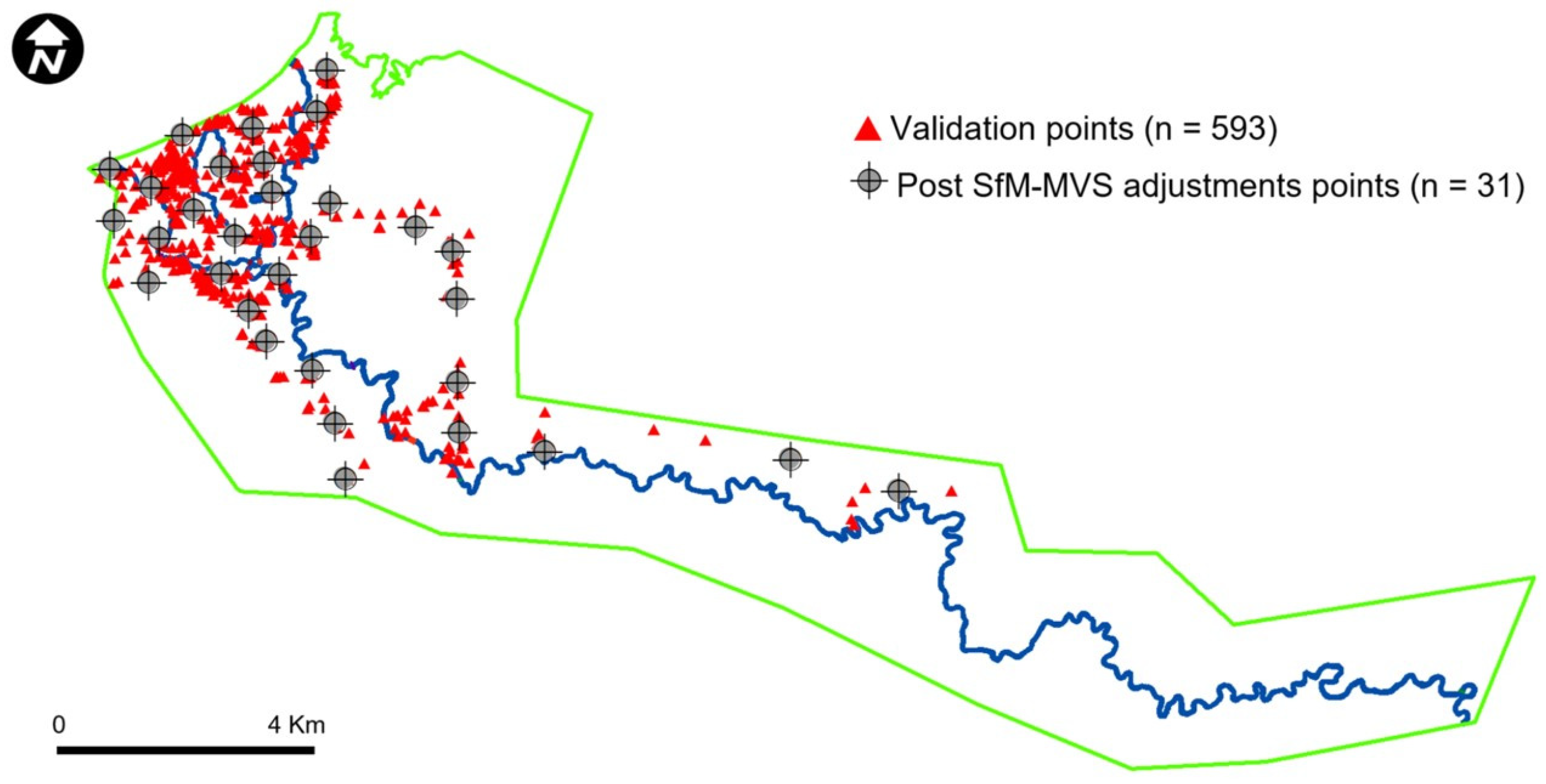
2.3. The Fluvial Domain Method (Concept)
- (1)
- Avoid the problem (a) by a preprocessing step where the points that fall on top of the channels are identified and excluded (which implies filtering based on a delineation of the channel polygons) and, subsequently, a DEM of the floodplain alone without channels is generated from the remaining points.
- (2)
- Take advantage of the fact that, by design, the airborne image acquisition occurred during the dry season to use the complement of the dataset—that is, only those points falling on top of the channel polygons—to construct a DEM exclusive to such polygons. Owing to the scarcity of data and the fact that the channel, even in the dry season, is not necessarily completely without water, this surface also presents defects (bumps) along its main direction (the channel thalweg). Therefore, it does not yet solve the problem (b), but it is a first approximation of the channel bottom.
- (3)
- Correct the channel bottom with a priori criteria (that is, without using further data acquired on the ground). To do this, first, the elevation long profile (affected by defects during interpolation) is obtained; then, it is corrected using the semi-automatic smoothing procedure, applying the principle that the bottom cannot significantly ascend and should not display falls unless there is some geologic fault or rocky outcrop (detectable from the available thematic maps). This procedure yields a much more reasonable shape for the long profile. Eventually, field data (bottom elevation data from topographic measurements) can be included (see Section 2.2.3). This corrected elevation long profile is transformed into a new surface (the fluvial domain), constructed in a GIS a series of transects (with the width of the channel polygon), which are then interpolated into a smooth raster surface. This solves problem (b).
- (4)
- Finally, the floodplain DEM and the smoothed bottom surfaces of all channels, which are the primary outputs of the method, are integrated to obtain the final complete DEM.

2.4. SfM-MVS Image Processing and Preliminary DEM Generation
- (1)
- Image alignment and obtaining a sparse point cloud (aero-triangulation): Photogrammetric aero-triangulation processing was performed using Agisoft Metashape®, version 2.1.2 on a 64-bit Windows system with an Intel Core i7-6700HQ processor at 2.60 GHz (4 physical and 8 logical cores) and 32 GB of RAM. For image alignment, a medium precision with a generic preselection of 120,000 key points was used. After removing outlier points using the gradual selection method, a reprojection error of 0.47 pixels was obtained in the preliminary sparse point cloud (<1 pixel being recommended). Subsequently, the synthetic control point method proposed by Escobar-Villanueva et al. (2019) [28] was implemented to optimize the geometry of the sparse point cloud. Using 33 control points derived from an orthomosaic (20 cm/pixel) and a Digital Terrain Model (DTM, 10 m), both deliverables from the contractor (Section 2.2.1), the Mean Error was reduced to 9.48 cm in X, 8.51 cm in Y, and 62.41 cm in Z, for a total of 63.70 cm.
- (2)
- Point cloud densification and ground classification: To densify the sparse point cloud, the SfM-MVS workflow with Metashape was continued: a medium-quality and moderate depth filtering were used [73]. Subsequently, a rectangular area covering the polygon of interest was delimited, and densification was carried out. Finally, the dense point cloud was exported in *.las format and cropped to the area of interest (green polygon, Figure 1). Ground point classification was performed semi-automatically, given the dense vegetation covering both the floodplain and the channel margins (see Figure 2). To ensure high reliability in the identification of exclusive ground points, very strict filtering parameters were established, with the aim of identifying and eliminating vegetation. The “Auto-classify Ground Points” tool of Global Mapper® version 18 software was used, combined with manual edits. This algorithm, based on the analysis of the terrain curvature and the elimination of outliers, applies a particularly severe filter to the dense point cloud, resulting in the classification of a significantly reduced number of ground points compared to the original total (8% of the points classified as terrain). The parameters used include a base cell size of 6 m to calculate curvature deviations; a minimum height of 0.15 m to exclude points not belonging to the terrain; and maximum values of 5 m for the height delta, 7.5 degrees for the slope, and 150 m for the width of structures such as buildings. Additionally, manual classifications were performed on linear features, such as embankments and roads, assigning them as part of the terrain. Furthermore, anomalous points were removed through visual inspection of wide transects (between 100 and 200 m wide).
- (3)
- Preliminary DEM generation: This step generates the initial DEM—a crucial input for the proposed method but not the final product. First, the point cloud classified as terrain, with an average distance of 2 m between points and irregular distribution, was interpolated to create a preliminary raster DEM (*.tif format) that included raw elevation data, including preliminary channel information. This early DEM serves as the main altimetric data input for the proposed bathymetric adjustment. Subsequently, to prevent artificial subsidence along the river channel surroundings (see Figure 4), the above-mentioned *.tif DEM is exported to *.las (a point cloud format), excluding the channel points from the interpolation process (defined by the delineated river–channel polygon with an additional buffer) and, therefore, filling the space between the river margins. This step mitigates the local influence of lower elevation point tendencies, which are often misclassified by the Global Mapper “Auto-classify Ground Points” algorithm. The obtained channel-free *.las DEM, corrected for subsidence anomalies, facilitates subsequent floodplain altimetric adjustment and integration with the proposed method’s channel output (also in *.las). ArcGIS Pro’s (version 3.0) “LAS Dataset to Raster” tool performed the interpolation, while Global Mapper’s version 18 “LIDAR-QC” tool handled the final altimetric adjustment, using the 31-ground survey GNSS-RTK points distributed in the study area (gray points Figure 3, Section 2.2.3).
2.5. River Channel Bottom Generation and Final DEM Integration (Detailed Explanation)
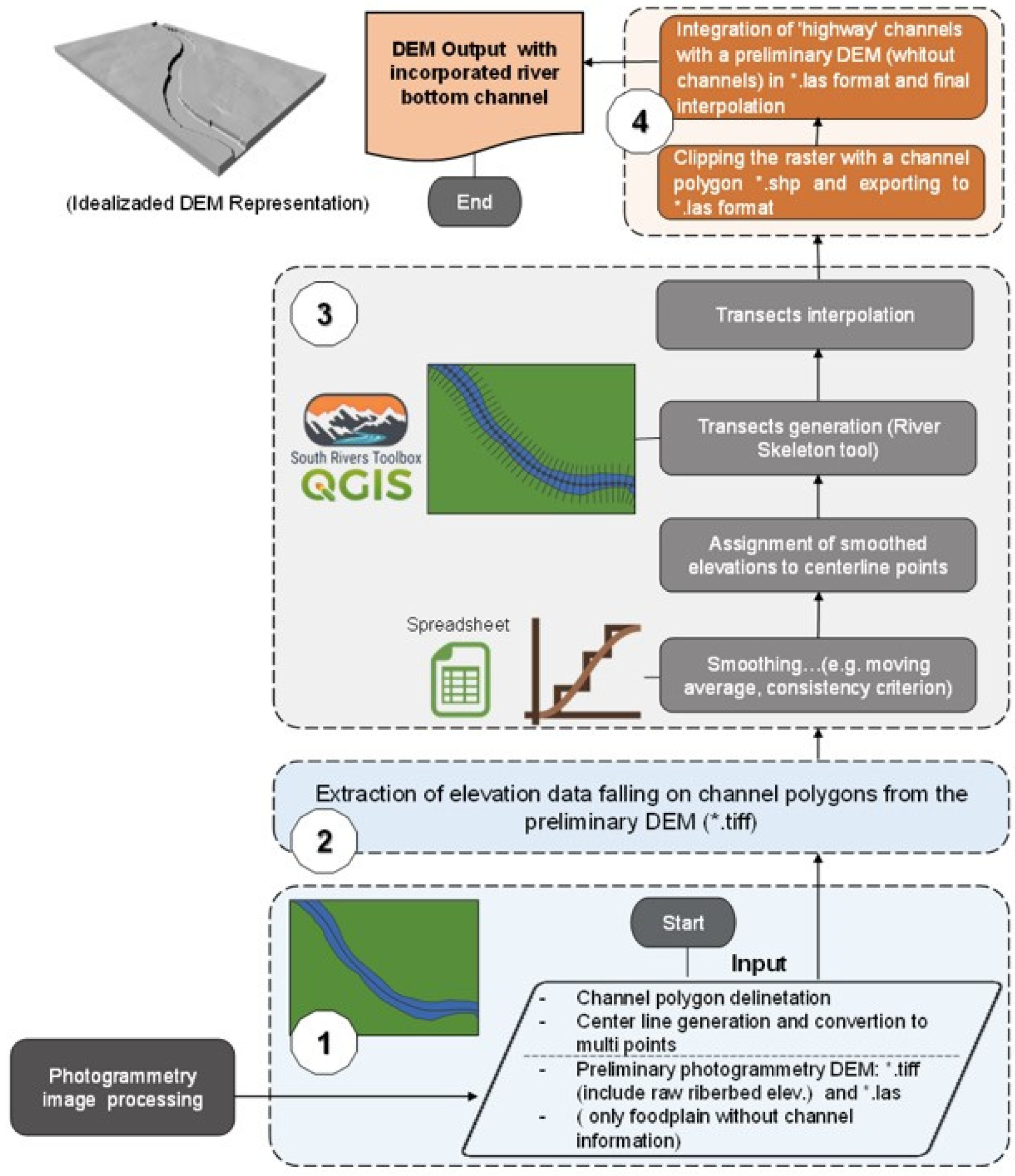
2.6. Validation of the Final DEM
- (1)
- Validation in the floodplain: The altimetric (Z) accuracy of the DSM and DEM generated (predicted) for the floodplain was validated by comparison with the reference topographic data (observed) obtained from GNSS RTK surveys (Figure 3, red triangles, Section 2.2.2). The Mean Error (ME—Equation (1)), the Mean Absolute Error (MAE—Equation (2)), and the Root Mean Square Error (RMSE—Equation (3)) were calculated to evaluate the accuracy of the DEM. The n term is the number of samples in altimetric surveys:
- (2)
- Validation in the river channel: To facilitate validation of the final DEM, its topographic sections were compared with standardized depth (h) profiles at eight cross-sections (see location Figure 1, Section 2.2.2). For this purpose, the Mean Absolute Percentage Error (MAPE—Equation (4) [75]) was considered as a metric to evaluate the accuracy of the final DEM of the proposed method. The validation of the final DEM for the channel output was performed by comparing its predicted channel depth profiles with the observed field data from eight (n = 8) cross-sections. The n term is the number of sample depth observations. The MAPE equation was used as follows:
3. Results
3.1. Accuracy Assessment of Photogrammetrically Derived Models: Floodplain
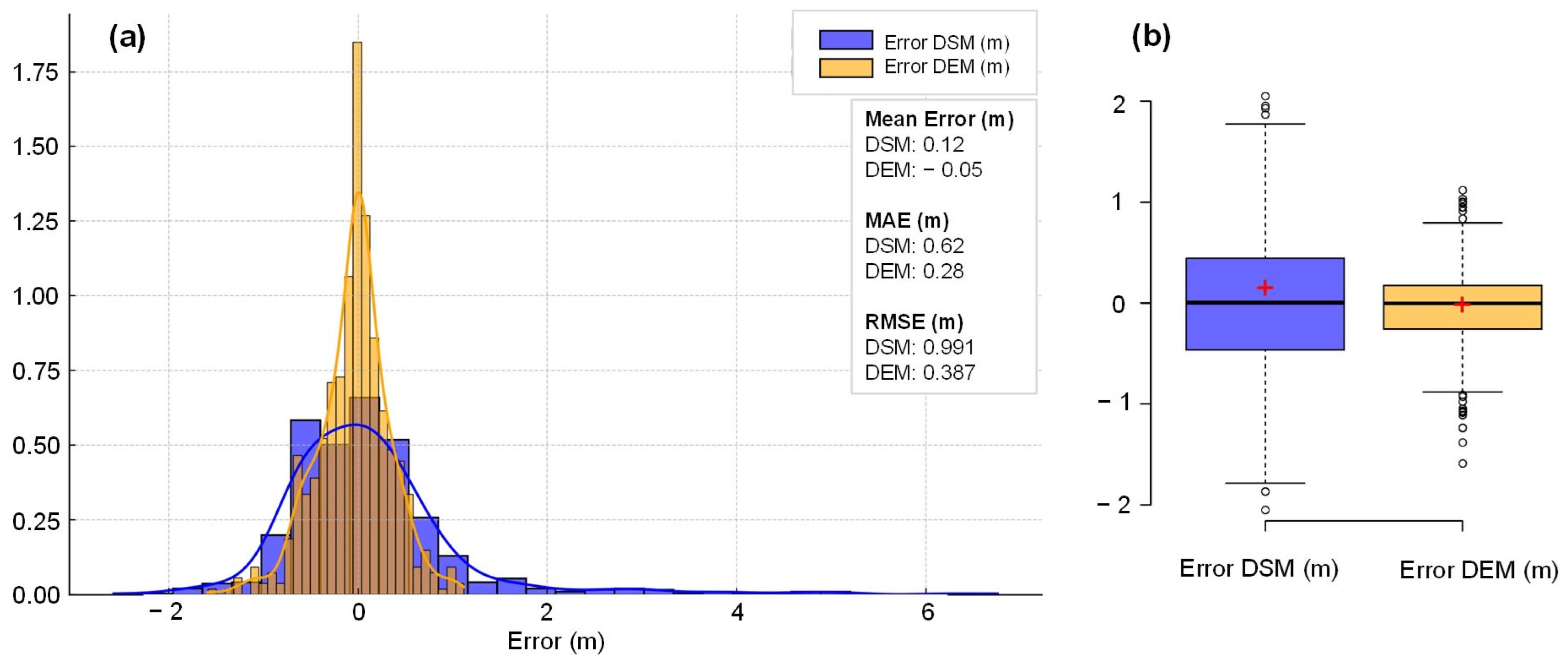
3.2. Proposed Method Application and Channel Bottom Refinements
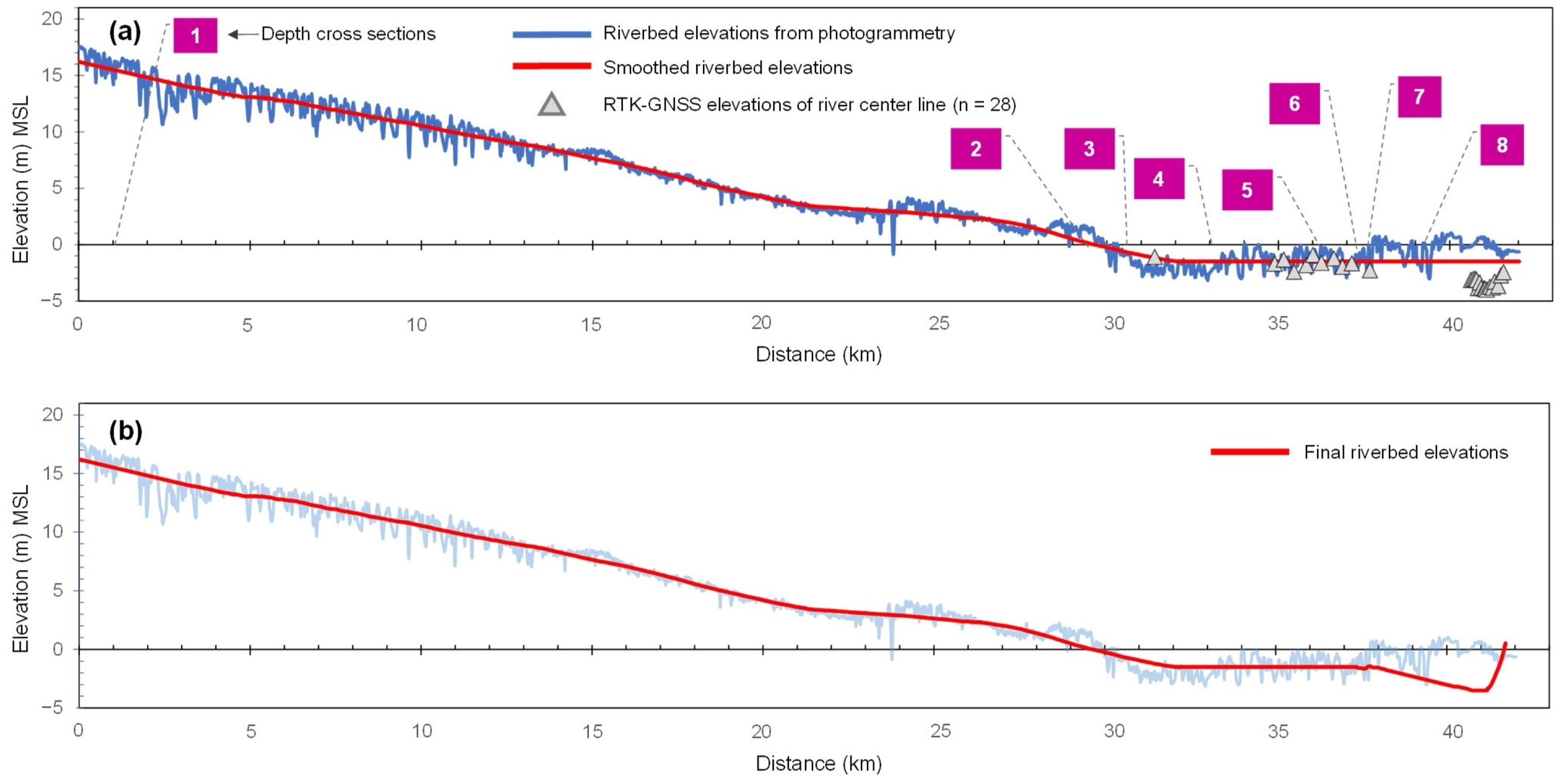
3.3. Accuracy Assessment of Photogrammetrically Derived Models: River Channels
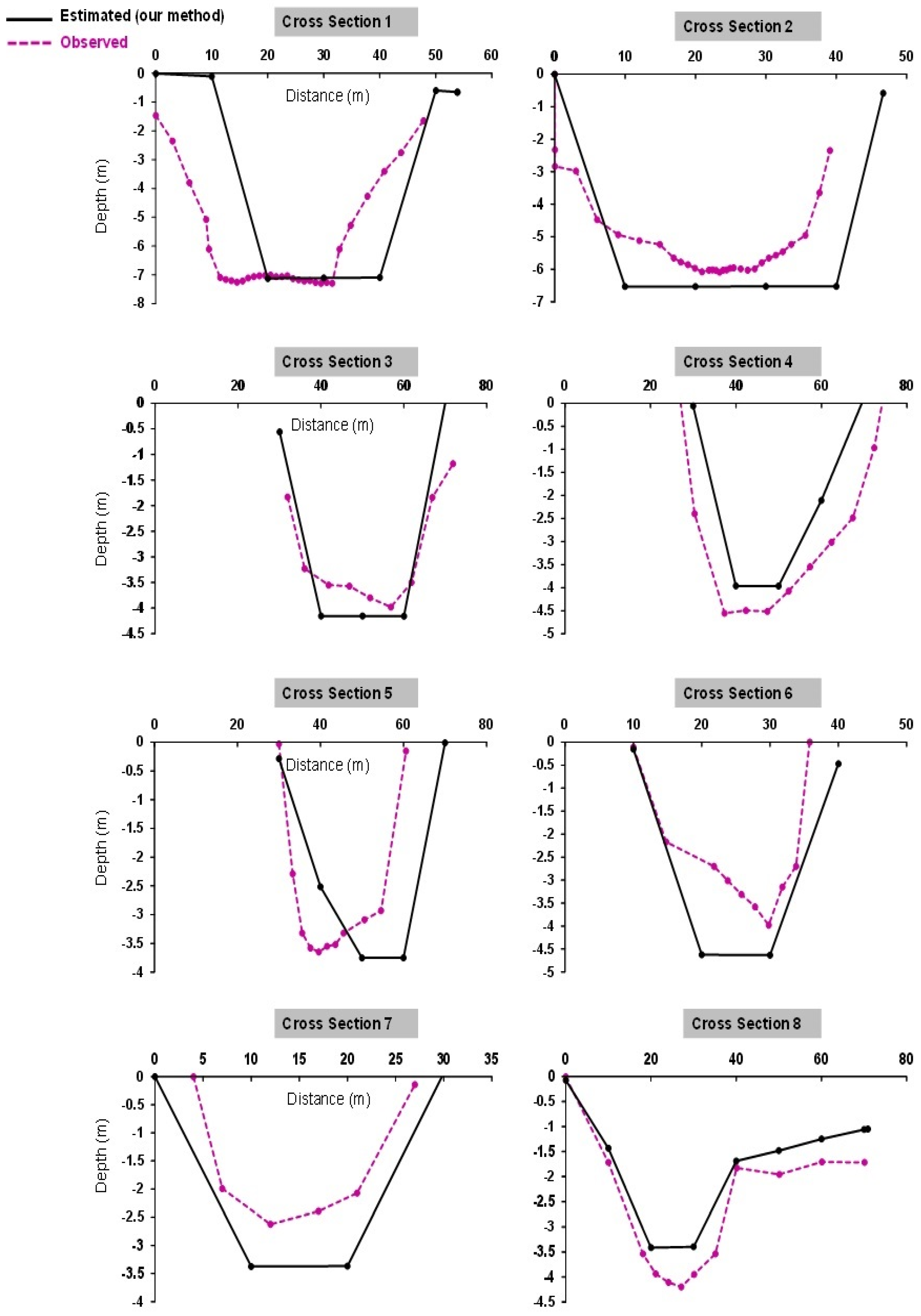

4. Discussion
4.1. Advantages of the Fluvial Domain Method in Contexts with Limited Information
4.2. Critical Analysis of the Method’s Scope
4.3. Implications for the Application of the Proposed Method and Future Work
5. Conclusions
Author Contributions
Funding
Data Availability Statement
Acknowledgments
Conflicts of Interest
Abbreviations
| DEM | Digital Elevation Model |
| DSM | Digital Surface Model |
| GIS | Geographic Information System |
| GNSS-RTK | Global Navigation Satellite System-Real-Time Kinematic |
| GSD | Ground Sample Distance |
| LiDAR | Light Detection and Ranging |
| m.a.s.l. | Meters above sea level |
| MSL | Mean sea level |
| MAE | Mean Absolute Error |
| MAPE | Mean Absolute Percentage Error |
| RGBI | Red, Green, Blue, Infrared (referring to spectral bands in imagery) |
| RMSE | Root Mean Square Error |
| SfM-MVS | Structure from Motion-Multi-View Stereo |
| UAV | Unmanned Aerial Vehicle (drones) |
References
- Toschi, I.; Remondino, F. Geomatics Mapping of Natural Hazards: Overview and Experiences. Int. Arch. Photogramm. Remote Sens. Spatial Inf. Sci. 2018, XLII, 505–512. [Google Scholar] [CrossRef]
- Forlani, G.; Roncella, R.; Diotri, F. Production of High-Resolution Digital Terrain Models in Mountain Regions to Support Risk Assessment. Geomat. Nat. Hazards Risk 2015, 6, 379–397. [Google Scholar] [CrossRef][Green Version]
- Granshaw, S.I. Photogrammetric Terminology: Fourth Edition. Photogramm. Rec. 2020, 35, 143–288. [Google Scholar] [CrossRef]
- Guth, P.L.; Van Niekerk, A.; Grohmann, C.H.; Muller, J.P.; Hawker, L.; Florinsky, I.V.; Gesch, D.; Reuter, H.I.; Herrera-Cruz, V.; Riazanoff, S.; et al. Digital Elevation Models: Terminology and Definitions. Remote Sens. 2021, 13, 3581. [Google Scholar] [CrossRef]
- Alho, P.; Hyyppä, H.; Hyyppä, J. Consequence of DTM Precision for Flood Hazard Mapping: A Case Study in SW Finland. Nord. J. Surv. Real Estate Res. 2009, 6, 21–39. [Google Scholar]
- Tauro, F.; Pagano, C.; Phamduy, P.; Grimaldi, S.; Porfiri, M. Large-Scale Particle Image Velocimetry From an Unmanned Aerial Vehicle. IEEE/ASME Trans. Mechatronics 2015, 20, 3269–3275. [Google Scholar] [CrossRef]
- Flener, C.; Vaaja, M.; Jaakkola, A.; Krooks, A.; Kaartinen, H.; Kukko, A.; Kasvi, E.; Hyyppä, H.; Hyyppä, J.; Alho, P. Seamless Mapping of River Channels at High Resolution Using Mobile LiDAR and UAV-Photography. Remote Sens. 2013, 5, 6382–6407. [Google Scholar] [CrossRef]
- Wechsler, S.P. Uncertainties Associated with Digital Elevation Models for Hydrologic Applications: A Review. Hydrol. Earth Syst. Sci. 2007, 11, 1481–1500. [Google Scholar] [CrossRef]
- Li, J.; Wong, D.W.S. Effects of DEM Sources on Hydrologic Applications. Comput. Environ. Urban Syst. 2010, 34, 251–261. [Google Scholar] [CrossRef]
- Muhadi, N.A.; Abdullah, A.F.; Bejo, S.K.; Mahadi, M.R.; Mijic, A. The Use of LiDAR-Derived DEM in Flood Applications: A Review. Remote Sens. 2020, 12, 2308. [Google Scholar] [CrossRef]
- Hashemi-Beni, L.; Jones, J.; Thompson, G.; Johnson, C.; Gebrehiwot, A. Challenges and Opportunities for UAV-Based Digital Elevation Model Generation for Flood-Risk Management: A Case of Princeville, North Carolina. Sensors 2018, 18, 3843. [Google Scholar] [CrossRef] [PubMed]
- Annis, A.; Nardi, F.; Petroselli, A.; Apollonio, C.; Arcangeletti, E.; Tauro, F.; Belli, C.; Bianconi, R.; Grimaldi, S. UAV-DEMs for Small-Scale Flood Hazard Mapping. Water 2020, 12, 1717. [Google Scholar] [CrossRef]
- Nardini, A.; Yepez, S.; Zuniga, L.; Gualtieri, C.; Bejarano, M.D. A Computer Aided Approach for River Styles-Inspired Characterization of Large Basins: The Magdalena River (Colombia). Water 2020, 12, 1147. [Google Scholar] [CrossRef]
- Cea, L.; Costabile, P. Flood Risk in Urban Areas: Modelling, Management and Adaptation to Climate Change: A Review. Hydrology 2022, 9, 50. [Google Scholar] [CrossRef]
- Schumann, G.J.P.; Bates, P.D. The Need for a High-Accuracy, Open-Access Global Digital Elevation Model. Front. Earth Sci. 2020, 8, 225. [Google Scholar] [CrossRef]
- Liu, X. Airborne LiDAR for DEM Generation: Some Critical Issues. Prog. Phys. Geogr. 2008, 32, 31–49. [Google Scholar]
- Cian, F.; Marconcini, M.; Ceccato, P.; Giupponi, C. Flood Depth Estimation by Means of High-Resolution SAR Images and Lidar Data. Hazards Earth Syst. Sci. 2018, 18, 3063–3084. [Google Scholar] [CrossRef]
- Andualem, T.G.; Peters, S.; Hewa, G.A.; Myers, B.R.; Boland, J.; Pezzaniti, D. Channel Morphological Change Monitoring Using High-Resolution LiDAR-Derived DEM and Multi-Temporal Imageries. Sci. Total Environ. 2024, 921, 171104. [Google Scholar] [CrossRef]
- Yepez, S.; Salas, F.; Nardini, A.; Valenzuela, N.; Osores, V.; Vargas, J.; Rodriguez, R.; Piegay, H. Semi-Automated Morphological Characterization Using South Rivers Toolbox. Proc. Int. Assoc. Hydrol. Sci. 2024, 385, 189–196. [Google Scholar] [CrossRef]
- Smith, M.W.; Carrivick, J.L.; Quincey, D.J. Structure from Motion Photogrammetry in Physical Geography. Prog. Phys. Geogr. 2016, 40, 247–275. [Google Scholar] [CrossRef]
- Fonstad, M.A.; Dietrich, J.T.; Courville, B.C.; Jensen, J.L.; Carbonneau, P.E. Topographic Structure from Motion: A New Development in Photogrammetric Measurement. Earth Surf. Process. Landf. 2013, 38, 421–430. [Google Scholar] [CrossRef]
- Musa, Z.N.; Popescu, I.; Mynett, A. A Review of Applications of Satellite SAR, Optical, Altimetry and DEM Data for Surface Water Modelling, Mapping and Parameter Estimation. Hydrol. Earth Syst. Sci. 2015, 19, 3755–3769. [Google Scholar] [CrossRef]
- Braun, A. Retrieval of Digital Elevation Models from Sentinel-1 Radar Data—Open Applications, Techniques, and Limitations. Open Geosci. 2021, 13, 532–569. [Google Scholar] [CrossRef]
- Arrighi, C.; Campo, L. Effects of Digital Terrain Model Uncertainties on High-Resolution Urban Flood Damage Assessment. J. Flood Risk Manag. 2019, 12, e12530. [Google Scholar] [CrossRef]
- Dietrich, J.T. Bathymetric Structure-from-Motion: Extracting Shallow Stream Bathymetry from Multi-View Stereo Photogrammetry. Earth Surf. Process. Landf. 2017, 42, 355–364. [Google Scholar] [CrossRef]
- Watanabe, Y.; Kawahara, Y. UAV Photogrammetry for Monitoring Changes in River Topography and Vegetation. Procedia Eng. 2016, 154, 317–325. [Google Scholar] [CrossRef]
- Casado, M.R.; Gonzalez, R.B.; Kriechbaumer, T.; Veal, A. Automated Identification of River Hydromorphological Features Using UAV High Resolution Aerial Imagery. Sensors 2015, 15, 27969–27989. [Google Scholar] [CrossRef]
- Villanueva, J.R.E.; Martínez, L.I.; Montiel, J.I.P. DEM Generation from Fixed-Wing UAV Imaging and LiDAR-Derived Ground Control Points for Flood Estimations. Sensors 2019, 19, 3205. [Google Scholar] [CrossRef]
- Rusnák, M.; Sládek, J.; Kidová, A.; Lehotský, M. Template for High-Resolution River Landscape Mapping Using UAV Technology. Meas. J. Int. Meas. Confed. 2018, 115, 139–151. [Google Scholar] [CrossRef]
- Colomina, I.; Molina, P. Unmanned Aerial Systems for Photogrammetry and Remote Sensing: A Review. ISPRS J. Photogramm. Remote Sens. 2014, 92, 79–97. [Google Scholar] [CrossRef]
- Wedajo, G.K. LiDAR DEM Data for Flood Mapping and Assessment; Opportunities and Challenges: A Review. J. Remote Sens. GIS 2017, 6, 4. [Google Scholar] [CrossRef]
- Eltner, A.; Kaiser, A.; Castillo, C.; Rock, G.; Neugirg, F.; Abellán, A. Image-Based Surface Reconstruction in Geomorphometry-Merits, Limits and Developments. Earth Surf. Dyn. 2016, 4, 359–389. [Google Scholar] [CrossRef]
- Brunier, G.; Fleury, J.; Anthony, E.J.; Gardel, A.; Dussouillez, P. Close-Range Airborne Structure-from-Motion Photogrammetry for High-Resolution Beach Morphometric Surveys: Examples from an Embayed Rotating Beach. Geomorphology 2016, 261, 76–88. [Google Scholar] [CrossRef]
- Eberhard, L.A.; Sirguey, P.; Miller, A.; Marty, M.; Schindler, K.; Stoffel, A.; Bühler, Y. Intercomparison of Photogrammetric Platforms for Spatially Continuous Snow Depth Mapping. Cryosph. Discuss. 2020, 15, 69–94. [Google Scholar] [CrossRef]
- Saglam, İ.E.; Karasaka, L. Evaluation of Multi-Camera Images in Different SfM-MVS Based Photogrammetric Software and Comparison of Digital Products in Generating 3D City Models. Ain Shams Eng. J. 2024, 15, 102700. [Google Scholar] [CrossRef]
- Yilmaz, V.; Konakoglu, B.; Serifoglu, C.; Gungor, O.; Gökalp, E. Image Classification-Based Ground Filtering of Point Clouds Extracted from UAV-Based Aerial Photos. Geocarto Int. 2018, 33, 310–320. [Google Scholar] [CrossRef]
- Tamminga, A.; Hugenholtz, C.; Eaton, B.; Lapointe, M. Hyperspatial Remote Sensing of Channel Reach Morphology and Hydraulic Fish Habitat Using an Unmanned Aerial Vehicle (UAV): A First Assessment in the Context of River Research and Management. River Res. Appl. 2015, 31, 379–391. [Google Scholar] [CrossRef]
- Zeybek, M.; Şanlıoğlu, İ. Point Cloud Filtering on UAV Based Point Cloud. Meas. J. Int. Meas. Confed. 2019, 133, 99–111. [Google Scholar] [CrossRef]
- Wang, Y.; Chen, A.S.; Fu, G.; Djordjević, S.; Zhang, C.; Savić, D.A. An Integrated Framework for High-Resolution Urban Flood Modelling Considering Multiple Information Sources and Urban Features. Environ. Model. Softw. 2018, 107, 85–95. [Google Scholar] [CrossRef]
- Laks, I.; Sojka, M.; Walczak, Z.; Wrózyński, R. Possibilities of Using Low Quality Digital Elevation Models of Floodplains in Hydraulic Numerical Models. Water 2017, 9, 283. [Google Scholar] [CrossRef]
- Becker, C.; Häni, N.; Rosinskaya, E.; D’Angelo, E.; Strecha, C. Classification of Aerial Photogrammetric 3D Point Clouds. Photogramm. Eng. Remote Sens. 2018, 84, 287–295. [Google Scholar] [CrossRef]
- Zhao, X.; Guo, Q.; Su, Y.; Xue, B. Improved Progressive TIN Densification Filtering Algorithm for Airborne LiDAR Data in Forested Areas. ISPRS J. Photogramm. Remote Sens. 2016, 117, 79–91. [Google Scholar] [CrossRef]
- Monteiro, E.S.V.; Fonte, C.C.; de Lima, J.L.M.P. Analysing the Potential of OpenStreetMap Data to Improve the Accuracy of SRTM 30 DEM on Derived Basin Delineation, Slope, and Drainage Networks. Hydrology 2018, 5, 34. [Google Scholar] [CrossRef]
- Li, W.; Li, D.; Fang, Z.N. Intercomparison of Automated Near-Real-Time Flood Mapping Algorithms Using Satellite Data and DEM-Based Methods: A Case Study of 2022 Madagascar Flood. Hydrology 2023, 10, 17. [Google Scholar] [CrossRef]
- Sahid, S. Enhancing Digital Elevation Model Accuracy for Flood Modelling—A Case Study of the Ciberes River in Cirebon Indonesia. Forum Geogr. 2024, 38, 40–56. [Google Scholar] [CrossRef]
- Coveney, S.; Roberts, K. Lightweight UAV Digital Elevation Models and Orthoimagery for Environmental Applications: Data Accuracy Evaluation and Potential for River Flood Risk Modelling. Int. J. Remote Sens. 2017, 38, 3159–3180. [Google Scholar] [CrossRef]
- Peramuna, P.D.P.O.; Neluwala, N.G.P.B.; Wijesundara, K.K.; DeSilva, S.; Venkatesan, S.; Dissanayake, P.B.R. Enhancing 2D Hydrodynamic Flood Model Predictions in Data-Scarce Regions through Integration of Multiple Terrain Datasets. J. Hydrol. 2024, 648, 132343. [Google Scholar] [CrossRef]
- Saksena, S.; Merwade, V. Incorporating the Effect of DEM Resolution and Accuracy for Improved Flood Inundation Mapping. J. Hydrol. 2015, 530, 180–194. [Google Scholar] [CrossRef]
- Dey, S.; Saksena, S.; Winter, D.; Merwade, V.; McMillan, S. Incorporating Network Scale River Bathymetry to Improve Characterization of Fluvial Processes in Flood Modeling. Water Resour. Res. 2022, 58, e2020WR029521. [Google Scholar] [CrossRef]
- Woodget, A.S.; Carbonneau, P.E.; Visser, F.; Maddock, I.P. Quantifying Submerged Fluvial Topography Using Hyperspatial Resolution UAS Imagery and Structure from Motion Photogrammetry. Earth Surf. Process. Landf. 2015, 40, 47–64. [Google Scholar] [CrossRef]
- Javernick, L.; Brasington, J.; Caruso, B. Modeling the Topography of Shallow Braided Rivers Using Structure-from-Motion Photogrammetry. Geomorphology 2014, 213, 166–182. [Google Scholar] [CrossRef]
- Parrot, J.F.; Ramírez Núñez, C. LiDAR DTM: Artifacts, and Correction for River Altitudes. Investig. Geogr. 2016, 2016, 28–39. [Google Scholar] [CrossRef]
- Brasington, J.; Vericat, D.; Rychkov, I. Modeling River Bed Morphology, Roughness, and Surface Sedimentology Using High Resolution Terrestrial Laser Scanning. Water Resour. Res. 2012, 48, 1–18. [Google Scholar] [CrossRef]
- Petrasova, A.; Mitasova, H.; Petras, V.; Jeziorska, J. Fusion of High-Resolution DEMs for Water Flow Modeling. Open Geospatial Data Softw. Stand. 2017, 2, 6. [Google Scholar] [CrossRef]
- Heidemann, H.K. Lidar Base Specification (Ver. 1.3, February 2018): U.S. Geological Survey Techniques and Methods, Book 11, Chapter B4; Office of Communications and Publishing: Reston, VA, USA, 2018. [Google Scholar]
- Griffiths, D.; Burningham, H. Comparison of Pre- and Self-Calibrated Camera Calibration Models for UAS-Derived Nadir Imagery for a SfM Application. Prog. Phys. Geogr. 2019, 43, 215–235. [Google Scholar] [CrossRef]
- Chen, Q.; Mudd, S.M.; Attal, M.; Hancock, S. Extracting an Accurate River Network: Stream Burning Re-Revisited. Remote Sens. Environ. 2024, 312, 114333. [Google Scholar] [CrossRef]
- Neal, J.; Hawker, L.; Savage, J.; Durand, M.; Bates, P.; Sampson, C. Estimating River Channel Bathymetry in Large Scale Flood Inundation Models. Water Resour. Res. 2021, 57, 2020WR028301. [Google Scholar] [CrossRef]
- Garrote, J.; González-Jiménez, M.; Guardiola-Albert, C.; Díez-Herrero, A. The Manning’s Roughness Coefficient Calibration Method to Improve Flood Hazard Analysis in the Absence of River Bathymetric Data: Application to the Urban Historical Zamora City Centre in Spain. Appl. Sci. 2021, 11, 9267. [Google Scholar] [CrossRef]
- Legleiter, C.J. The Optical River Bathymetry Toolkit. River Res. Appl. 2021, 37, 555–568. [Google Scholar] [CrossRef]
- Godfroy, J.; Lejot, J.; Demarchi, L.; Bizzi, S.; Piégay, H. Assessing the Feasibility of Mapping Channel Bathymetry of Long River Corridors from Hyperspectral Data across a Range of Flow Conditions. Int. J. Remote Sens. 2024, 45, 8123–8156. [Google Scholar] [CrossRef]
- Westoby, M.J.; Brasington, J.; Glasser, N.F.; Hambrey, M.J.; Reynolds, J.M. “Structure-from-Motion” Photogrammetry: A Low-Cost, Effective Tool for Geoscience Applications. Geomorphology 2012, 179, 300–314. [Google Scholar] [CrossRef]
- Manfreda, S.; Fortunato, S.; Sasso, D.; Pizarro, A.; Tauro, F. New Insights Offered by UAS for River Monitoring. In Applications of Small Unmanned Aircraft Systems; CRC Press: Boca Raton, FL, USA, 2019. [Google Scholar]
- Ngula Niipele, J.; Chen, J. The Usefulness of Alos-Palsar Dem Data for Drainage Extraction in Semi-Arid Environments in The Iishana Sub-Basin. J. Hydrol. Reg. Stud. 2019, 21, 57–67. [Google Scholar] [CrossRef]
- Vengoechea, A.; Rojano, R.; Arregoces, H. Dispersión y Concentración de Aerosoles Marinos PM 10 En Una Ciudad Costera Del Caribe Dispersion and Concentration of PM 10 Particles in a Caribbean Coastal City. Inf. Tecnológica 2018, 26, 123–130. [Google Scholar] [CrossRef]
- Castellanos Martínez, M.L.; Carabalí Angola, A. El delta del rio Ranchería: Una Mirada Biofísica y Social antes de la Represa; Universidad de La Guajira: Riohacha, Colombia, 2014; ISBN 978-958-8530-24-6. [Google Scholar]
- Fondo de Adaptación Contrato No. 127 de 2018 Consultoría para la Elaboración de un Ortofotomosaico Con la Georreferenciación de Todos los Elementos Existentes: (I) El Suministro de Fotografías Aéreas Digitales (II) la Digitalización de Elementos Cartográficos; y (III) la Ela. Available online: https://www.fondoadaptacion.gov.co/index.php/component/sppagebuilder/?view=page&id=934 (accessed on 8 April 2020).
- Fondo de Adaptación Contrato No. 217 de 2016 Elaborar Un Ortofotomosaico Con La Georeferenciación de Todos Los Elementos Existentes, Incluyendo: (I) La Toma de Fotografías Aéreas Digitales; (II) La Digitalización de Elementos Cartográficos; y (III) La Elaboración de Un Mode. Available online: https://www.fondoadaptacion.gov.co/index.php/component/sppagebuilder/?view=page&id=1559 (accessed on 8 April 2020).
- Pérez, J.I.; Escobar, J.R.; Fragozo, J.M. Modelación Hidráulica 2D de Inundaciones En Regiones Con Escasez de Datos: El Caso Del Delta Del Río Ranchería, Riohacha Colombia. Inf. Tecnológica 2018, 29, 143–156. [Google Scholar] [CrossRef]
- Yu, J.J.; Kim, D.W.; Lee, E.J.; Son, S.W. Determining the Optimal Number of Ground Control Points for Varying Study Sites through Accuracy Evaluation of Unmanned Aerial System-Based 3d Point Clouds and Digital Surface Models. Drones 2020, 4, 49. [Google Scholar] [CrossRef]
- Oniga, V.-E.; Breaban, A.-I.; Statescu, F. Determining the Optimum Number of Ground Control Points for Obtaining High Precision Results Based on UAS Images. Proceedings 2018, 2, 352. [Google Scholar] [CrossRef]
- Legleiter, C.J. Remote Measurement of River Morphology via Fusion of LiDAR Topography and Spectrally Based Bathymetry. Earth Surf. Process. Landf. 2012, 37, 499–518. [Google Scholar] [CrossRef]
- Agisoft LLC. Orthophoto and DEM Generation with Agisoft PhotoScan Pro 1.0.0; Agisoft LLC: St. Petersburg, Russia, 2013. [Google Scholar]
- Merwade, V.; Cook, A.; Coonrod, J. GIS Techniques for Creating River Terrain Models for Hydrodynamic Modeling and Flood Inundation Mapping. Environ. Model. Softw. 2008, 23, 1300–1311. [Google Scholar] [CrossRef]
- Pourghasemi, H.R.; Gokceoglu, C. Spatial Modeling in GIS and R for Earth and Environmental Sciences; Elsevier: Amsterdam, The Netherlands, 2019; ISBN 9780128152263. [Google Scholar]
- Strick, R.J.P.; Ashworth, P.J.; Sambrook Smith, G.H.; Nicholas, A.P.; Best, J.L.; Lane, S.N.; Parsons, D.R.; Simpson, C.J.; Unsworth, C.A.; Dale, J. Quantification of Bedform Dynamics and Bedload Sediment Flux in Sandy Braided Rivers from Airborne and Satellite Imagery. Earth Surf. Process. Landf. 2019, 44, 953–972. [Google Scholar] [CrossRef]
- Berra, E.F.; Peppa, M.V. Advances and Challenges of UAV SFM MVS Photogrammetry and Remote Sensing: Short Review. In Proceedings of the 2020 IEEE Latin American GRSS & ISPRS Remote Sensing Conference (LAGIRS), Santiago, Chile, 22–26 March 2020; pp. 533–538. [Google Scholar] [CrossRef]
- Kasvi, E.; Salmela, J.; Lotsari, E.; Kumpula, T.; Lane, S.N. Comparison of Remote Sensing Based Approaches for Mapping Bathymetry of Shallow, Clear Water Rivers. Geomorphology 2019, 333, 180–197. [Google Scholar] [CrossRef]
- Rusnák, M.; Goga, T.; Michaleje, L.; Michalková, M.Š.; Máčka, Z.; Bertalan, L.; Kidová, A. Remote Sensing of Riparian Ecosystems. Remote Sens. 2022, 14, 2645. [Google Scholar] [CrossRef]
- Zhang, K.; Gann, D.; Ross, M.; Biswas, H.; Li, Y.; Rhome, J. Comparison of TanDEM-X DEM with LiDAR Data for Accuracy Assessment in a Coastal Urban Area. Remote Sens. 2019, 11, 876. [Google Scholar] [CrossRef]
- Bigdeli, B.; Amini Amirkolaee, H.; Pahlavani, P. DTM Extraction under Forest Canopy Using LiDAR Data and a Modified Invasive Weed Optimization Algorithm. Remote Sens. Environ. 2018, 216, 289–300. [Google Scholar] [CrossRef]
- Tamminga, A.D.; Eaton, B.C.; Hugenholtz, C.H. UAS-Based Remote Sensing of Fluvial Change Following an Extreme Flood Event. Earth Surf. Process. Landf. 2015, 40, 1464–1476. [Google Scholar] [CrossRef]
- Woodget, A.S.; Dietrich, J.T.; Wilson, R.T. Quantifying Below-Water Fluvial Geomorphic Change: The Implications of Refraction Correction, Water Surface Elevations, and Spatially Variable Error. Remote Sens. 2019, 11, 2415. [Google Scholar] [CrossRef]
- Tonina, D.; McKean, J.A.; Benjankar, R.M.; Wright, C.W.; Goode, J.R.; Chen, Q.; Reeder, W.J.; Carmichael, R.A.; Edmondson, M.R. Mapping River Bathymetries: Evaluating Topobathymetric LiDAR Survey. Earth Surf. Process. Landf. 2019, 44, 507–520. [Google Scholar] [CrossRef]
- Manfreda, S.; Herban, S.; Arranz Justel, J.; Perks, M.; Mullerova, J.; Dvorak, P.; Vuono, P. Assessing the Accuracy of Digital Surface Models Derived from Optical Imagery Acquired with Unmanned Aerial Systems. Drones 2019, 3, 15. [Google Scholar] [CrossRef]
- James, M.R.; Chandler, J.H.; Eltner, A.; Fraser, C.; Miller, P.E.; Mills, J.P.; Noble, T.; Robson, S.; Lane, S.N. Guidelines on the Use of Structure-from-Motion Photogrammetry in Geomorphic Research. Earth Surf. Process. Landf. 2019, 44, 2081–2084. [Google Scholar] [CrossRef]
- Gichamo, T.Z.; Sazib, N.S.; Tarboton, D.G.; Dash, P. HydroDS: Data Services in Support of Physically Based, Distributed Hydrological Models. Environ. Model. Softw. 2020, 125, 104623. [Google Scholar] [CrossRef]
- US Army Corps of Enginners HEC River Analysis System: Terrain Modification Tools. Available online: https://www.hec.usace.army.mil/confluence/rasdocs/rmum/latest/terrain-modification (accessed on 15 January 2025).
| Camera Model | Resolution (px) | Focal Distance (mm) | Pixel Size (μm) |
|---|---|---|---|
| Vexcel UltraCam (350 images) | 8984 × 6732 | 51.8560 | 6 × 6 |
| Vexcel UltraCam (1050 images) | 10,328 × 7760 | 51.4783 | 5.2 × 5.2 |
| Type Model | Check Points (n) | Mean Error (m) | MAE (m) | RMSE (m) |
|---|---|---|---|---|
| DSM | 594 | 0.12 | 0.62 | 0.991 |
| Final DEM | 593 | −0.05 | 0.28 | 0.387 |
Disclaimer/Publisher’s Note: The statements, opinions and data contained in all publications are solely those of the individual author(s) and contributor(s) and not of MDPI and/or the editor(s). MDPI and/or the editor(s) disclaim responsibility for any injury to people or property resulting from any ideas, methods, instructions or products referred to in the content. |
© 2025 by the authors. Licensee MDPI, Basel, Switzerland. This article is an open access article distributed under the terms and conditions of the Creative Commons Attribution (CC BY) license (https://creativecommons.org/licenses/by/4.0/).
Share and Cite
Villanueva, J.R.E.; Pérez-Montiel, J.I.; Nardini, A.G.C. DEM Generation Incorporating River Channels in Data-Scarce Contexts: The “Fluvial Domain Method”. Hydrology 2025, 12, 33. https://doi.org/10.3390/hydrology12020033
Villanueva JRE, Pérez-Montiel JI, Nardini AGC. DEM Generation Incorporating River Channels in Data-Scarce Contexts: The “Fluvial Domain Method”. Hydrology. 2025; 12(2):33. https://doi.org/10.3390/hydrology12020033
Chicago/Turabian StyleVillanueva, Jairo R. Escobar, Jhonny I. Pérez-Montiel, and Andrea Gianni Cristoforo Nardini. 2025. "DEM Generation Incorporating River Channels in Data-Scarce Contexts: The “Fluvial Domain Method”" Hydrology 12, no. 2: 33. https://doi.org/10.3390/hydrology12020033
APA StyleVillanueva, J. R. E., Pérez-Montiel, J. I., & Nardini, A. G. C. (2025). DEM Generation Incorporating River Channels in Data-Scarce Contexts: The “Fluvial Domain Method”. Hydrology, 12(2), 33. https://doi.org/10.3390/hydrology12020033









